Earlier this week I wrote about the relative sizes of the U.S. and Chinese air forces, and how China needs to manage its anti-air “fortifications” in order to close the gap with the United States. However, it’s worth a look to see how differently the major air forces of the Asia-Pacific have structured themselves.
Let’s take the United States as a baseline (although the U.S. arrangement is one of the most unusual in the world, most people are familiar with the basic dynamics). As of December 2015, the United States operated 13,655 aircraft; 5,062 in the Air Force, 4,759 in the Army, 1,249 in the Marine Corps, and 2,585 in the Navy. Between the USAF, USMC, and USN, the United States flies 2,838 combat aircraft (fighters, bombers, and attack aircraft), constituting 21 percent of the total fleet. The rest of the U.S. air forces consist of helicopters and a wide array of support aircraft, including the transport and tanker aircraft necessary to deploying and maintaining vast overseas operations.
China has a radically different air posture. 51 percent of China’s 3,010 operational aircraft fulfill combat roles, mostly (1,308) with the PLAAF. China has far smaller transport and tanker fleets than the United States, commensurate with the PLA’s minimal overseas presence. This force structure means that the PLA can compete with the United States on China’s home turf, but struggles to make a broader global impact.
The rest of Asia varies quite a bit. 30 percent of South Korea’s 1,495 aircraft are combat models, compared to 61 percent of North Korea’s 944 planes. Fighters and fighter-bombers make up 25 percent of Vietnam’s 289 aircraft. The figure for Japan is 18 percent (out of a total of 1,575). The combat aircraft of the Indian Navy and Air Force make up 34 percent of the total of 1941 planes.
What are the implications of these differences? One is that the constellation of military institutions matters a great deal for aerial force structure. The United States Army has more combat helicopters than China has military aircraft, an outcome that surely owes something to the fact that the U.S. Army and U.S. Air Force struggle to cooperate over support missions. The Japanese Ground Self Defense Force, which models much of its doctrine around that of the U.S. Army, has a similar helicopter concentration. Another is that distance matters. Both the United States and Japan require a greater infrastructure for “getting to the action” than most of the other states, and their procurement choices reflect this. Vietnam, China, and the Koreas can afford to concentrate on short-range aircraft because their concerns lie immediately upon their borders.
Most importantly, we should continue to appreciate that raw numbers tell only a very limited part of the story of air forces (and armies, and navies). Distance, structure, and posture matter a great deal in how air forces conduct themselves, both in war and peace.

































